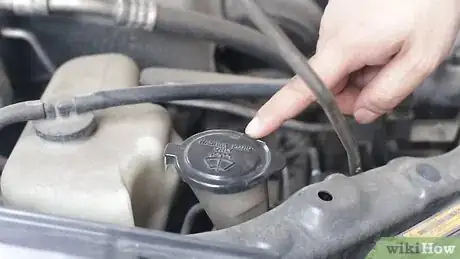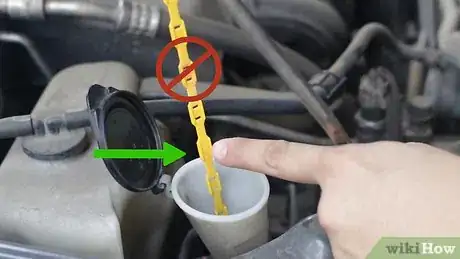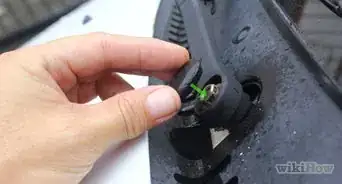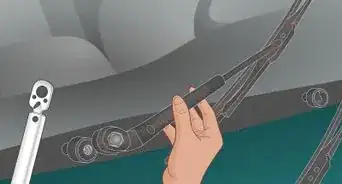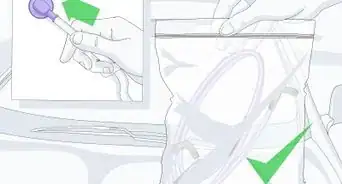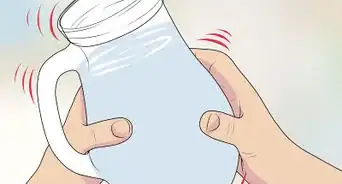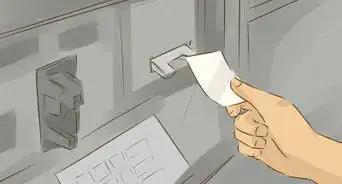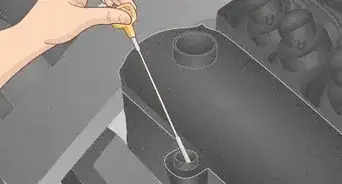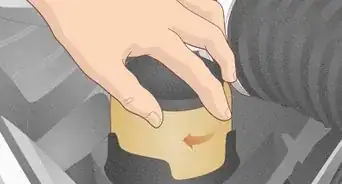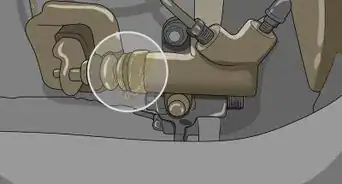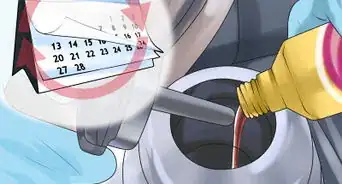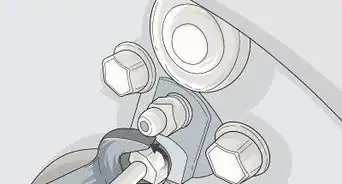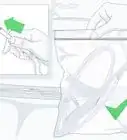This article was co-authored by Hovig Manouchekian. Hovig Manouchekian is an Auto Repair and Design Specialist and the Manager of Funk Brothers Auto, a family-owned business operated since 1925. With over 30 years of experience in the automotive industry, Hovig specializes in the process of auto repair and maintenance. He is also very knowledgeable in common automotive issues and needs including engine repair, battery replacement, and windshield accessory and maintenance. Hovig's knowledge and hard work have contributed to Funk Brothers Auto winning Angie's List Super Service Award for five consecutive years.
This article has been viewed 321,915 times.
If your windshield washer jets don’t spray anything when you engage them or the low washer fluid light comes on in your vehicle, it is likely time to refill the windshield washer fluid reservoir. In most vehicles, refilling the washer fluid is a very straight forward process. Purchase new washer fluid at your local large retail or auto parts store. There are no tools required for this project.
Things You Should Know
- Find the washer fluid reservoir next to the engine bay and unscrew the cap.
- Use a funnel to pour fluid into the reservoir. Stop when it reaches the “full” line.
- Replace the reservoir cap and wipe up any spilled wiper fluid.
- Whenever the low washer fluid symbol appears on your dashboard, add more washer fluid.
Steps
Finding the Reservoir
-
1Locate the windshield washer fluid reservoir. The windshield washer fluid reservoir may be located in a number of places depending on the year, make and model of your vehicle. It is usually mounted along the side of the engine bay, and can often be found near the windshield along the firewall.[1]
- The windshield washer fluid reservoir will be marked with a symbol that looks like windshield with wipers moving.
- If you are unable to locate the reservoir, refer to your vehicle’s owner’s manual for guidance.
-
2Identify the low and full lines on the reservoir. Once you locate the reservoir, identify the low and high fill lines along the side. Most windshield washer fluid reservoirs are made of translucent plastic with lines along the side that indicate how full with fluid the reservoir is. Verify that the reservoir is indeed low on fluid before adding more.[2]
- If the windshield washer fluid reservoir is full but will not spray, it could be due to clogged lines.
- If the low washer fluid light came on in your car but the reservoir is full, it may be due to a faulty sensor.
Advertisement -
3Open the cap and set it aside. Twist the cap counter-clockwise to unscrew it and lift it off of the reservoir. Set the cap aside someplace safe. Be sure you don’t put it down in dirt or debris so nothing accidentally falls into the fluid when you return the cap.[3]
- Dirt and debris is the reservoir can result in clogging the windshield washer lines.
- Make sure the cap is not damaged. If it cannot be closed back onto the reservoir properly, the cap will need to be replaced.
Pouring Washer Fluid
-
1Add windshield washer fluid until it reaches the full line. Use a funnel or the spout on the windshield washer fluid bottle to pour fluid into the reservoir until it reaches the “full” line on the side. Wipe up any spilled washer fluid with paper towels or a rag.[4]
- You should be able to see through the side of the reservoir to know when it is full.
-
2Avoid over filling the reservoir. Because fluid can expand when heated, it’s important that you do not overfill the reservoir. When the fluid warms due to the high engine temperatures under the hood, the pressure could cause the reservoir to crack and leak if there is too much fluid in it.[5]
- Use a turkey baster to suck extra fluid back out of the reservoir in the event you over fill it.
-
3Screw the cap back into place. With the reservoir filled with washer fluid, pick the cap up from where you stored it. Use a rag or paper towels to wipe the cap down to ensure there is no dirt or debris stuck to it.[6]
- Turn the cap clockwise to re-secure it on the reservoir.
- If the cap is damaged, you can purchase replacement ones at your local auto parts store.
-
4Start the vehicle and test the fluid sprayer. Get back into the vehicle and insert the key into the ignition. Start the engine and engage the washer fluid in the manner you normally would to make sure it is working properly.[7]
Prepping to Add Washer Fluid
-
1Choose a type of windshield washer fluid. In order to be effective, it’s important that you not use just water in your windshield washer fluid. Regular windshield washer fluid is designed to prevent streaking and not to freeze if the temperature gets too cold. However, if you live in an area that frequently experiences extremely low temperatures, an anti-freezing washer fluid may be your best bet.[10]
- Anti-freezing washer fluid can help defrost your windshield when a light layer of ice forms on it on cold mornings.
- Other windshield washer fluids can contain chemicals that makes water bead off of the glass, allowing for increased visibility when driving in the rain.
-
2Mix concentrated fluid with water. If you choose to purchase a concentrated windshield washer fluid, you will need to mix it with water before adding it to the vehicle. Like anti-freeze, concentrated windshield washer fluid can usually be mixed with water at a 50/50 ratio.[11]
- A 50/50 ratio of water to fluid means half water, half fluid.
- Follow the directions provided on the specific brand of concentrated washer fluid you purchase.
-
3Park on level ground. In order to get an accurate understanding of how much washer fluid is still in your vehicle, as well as how much you have added, it’s important that the reservoir sits level. In order to do so, park the vehicle on an even, flat surface.[12]
- Parking at an angle such as on a hill will make it difficult to read how much fluid is in the reservoir.
-
4Open the hood. To open the hood of your vehicle, locate the release near the door frame on the driver’s side. The release is usually labeled with a small symbol that represents the front of vehicle with the hood open. Pull the release toward you to disengage the hood latch. Once out of the car, you will need to release the safety latch as well.[13]
- Release the safety latch by pressing on the lever beneath the hood or through the grill at the front of the vehicle.
- If you are unsure where to locate the release, refer to your vehicle’s owner’s manual for guidance.
Expert Q&A
-
QuestionHow do you troubleshoot a windshield washer pump if it is broken?
 Hovig ManouchekianHovig Manouchekian is an Auto Repair and Design Specialist and the Manager of Funk Brothers Auto, a family-owned business operated since 1925. With over 30 years of experience in the automotive industry, Hovig specializes in the process of auto repair and maintenance. He is also very knowledgeable in common automotive issues and needs including engine repair, battery replacement, and windshield accessory and maintenance. Hovig's knowledge and hard work have contributed to Funk Brothers Auto winning Angie's List Super Service Award for five consecutive years.
Hovig ManouchekianHovig Manouchekian is an Auto Repair and Design Specialist and the Manager of Funk Brothers Auto, a family-owned business operated since 1925. With over 30 years of experience in the automotive industry, Hovig specializes in the process of auto repair and maintenance. He is also very knowledgeable in common automotive issues and needs including engine repair, battery replacement, and windshield accessory and maintenance. Hovig's knowledge and hard work have contributed to Funk Brothers Auto winning Angie's List Super Service Award for five consecutive years.
Auto Repair & Design Specialist First, try activating the washer fluid pump. If you hear it activating, that will usually clear the pump from malfunction. If that doesn't work, check out the plumbing next. Specifically check if the jets are disconnected, which happens often. If there is no sound coming from the pump that activates the jets from the inside of the vehicle, that is a clear sign that it's been disconnected.
First, try activating the washer fluid pump. If you hear it activating, that will usually clear the pump from malfunction. If that doesn't work, check out the plumbing next. Specifically check if the jets are disconnected, which happens often. If there is no sound coming from the pump that activates the jets from the inside of the vehicle, that is a clear sign that it's been disconnected. -
QuestionI'm adding an anti-freeze for windscreen solution to my washer tank. Do I need to empty out the existing washer fluid before adding this one in?
 Community AnswerDon't add antifreeze to your washer fluid reservoir. It will damage your paint.
Community AnswerDon't add antifreeze to your washer fluid reservoir. It will damage your paint. -
QuestionIs there a separate reservoir for rear windows?
 Community AnswerNo, there is not. Fluid from the same reservoir is used for front and rear windshields.
Community AnswerNo, there is not. Fluid from the same reservoir is used for front and rear windshields.
References
- ↑ http://www.sears.com/articles/automotive/replacement-auto-parts/wiper-blades/how-to-add-windshield-washer-fluid.html
- ↑ http://www.sears.com/articles/automotive/replacement-auto-parts/wiper-blades/how-to-add-windshield-washer-fluid.html
- ↑ https://blog.openbay.com/how-to-refill-your-windshield-wiper-fluid/
- ↑ https://blog.openbay.com/how-to-refill-your-windshield-wiper-fluid/
- ↑ https://blog.openbay.com/how-to-refill-your-windshield-wiper-fluid/
- ↑ https://blog.openbay.com/how-to-refill-your-windshield-wiper-fluid/
- ↑ http://www.supaquick.com/how-do-i-refill-my-windscreen-wiper-fluid
- ↑ Hovig Manouchekian. Auto Repair & Design Specialist. Expert Interview. 23 February 2021.
- ↑ Hovig Manouchekian. Auto Repair & Design Specialist. Expert Interview. 23 February 2021.
- ↑ http://knowhow.napaonline.com/windshield-wiper-fluid-what-kind-do-you-need-and-why/
- ↑ http://www.dummies.com/home-garden/car-repair/maintaining-your-wipers-and-washer-fluid/
- ↑ http://www.dummies.com/home-garden/car-repair/maintaining-your-wipers-and-washer-fluid/
- ↑ http://www.sears.com/articles/automotive/replacement-auto-parts/wiper-blades/how-to-add-windshield-washer-fluid.html
About This Article
To add windshield washer fluid to your vehicle, first locate the windshield washer fluid reservoir. It is usually located along the side of the engine bay near the windshield. The reservoir lid is marked with an image of a windshield with a jet of liquid in front of it or a pair of moving windshield wipers. Check the sides of the reservoir to see how far below the fill line the liquid is, or use the built-in dipstick if it has one. To start filling, flip up the cap on the reservoir or unscrew it and set it aside. Use a funnel or the spout on the bottle of windshield wiper fluid to carefully pour the fluid in until it reaches the fill line. If your reservoir doesn’t have a fill line, use a dipstick to check the level of fluid instead. Be careful not to overfill the reservoir, since overfilling can cause leaks or damage the reservoir. Put the cap back on, then start your car and test the windshield washer to make sure it’s working properly. To learn how to choose a type of windshield washer fluid, keep reading!
